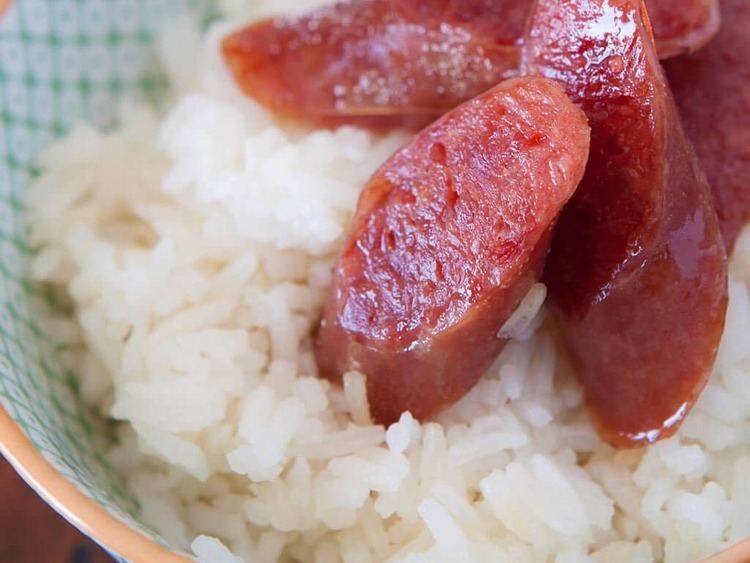Alternative names lap cheong, lap chong | Course Sausage | |
 | ||
Similar Larb, Rousong, Shiitake, Fried rice, Char siu | ||
eng sub how to make chinese sausage
Chinese sausage is a generic term referring to the many different types of sausages originating in China. The southern flavor of Chinese sausage is commonly known by its Cantonese name 'lap ceung' (or 'lap chong') (simplified Chinese: 腊肠; traditional Chinese: 臘腸; pinyin: làcháng; Jyutping: laap6 coeng2; Cantonese Yale: laahp chéung).
Contents
- eng sub how to make chinese sausage
- How to cook chinese sausage
- Varieties
- Southern China and Hong Kong
- Northern China
- Vietnam
- Myanmar
- Philippines
- Singapore
- Taiwan
- Thailand
- Outside Asia
- References

How to cook chinese sausage
Varieties
There is a choice of fatty or lean sausages. There are different kinds ranging from those made using fresh pork to those made using pig livers, duck livers and even turkey livers. Usually a sausage made with liver will be darker in color than one made without liver. Recently, there have even been countries producing chicken Chinese sausages. Traditionally they are classified into two main types. It is sometimes rolled and steamed in dim sum.

Southern China and Hong Kong
Chinese sausage is used as an ingredient in quite a number of dishes in the southern Chinese provinces of Guangdong, Fujian, Jiangxi, Sichuan, and Hunan, and also Hong Kong. Sichuan sausage also contains red chili powder, Sichuan pepper powder, and Pixian bean sauce, to characterise the sausage with a special flavour. Two common examples of such dishes include fried rice and lo mai gai (糯米雞). The traditional unpackaged forms are usually found in street markets or wet markets.
Wing Wah is a famous Hong Kong company that produces Chinese sausages.
Northern China
In northeast China, especially Heilongjiang's largest city Harbin, a popular regional speciality is smoked savory red sausage (simplified Chinese: 红肠; traditional Chinese: 紅腸; pinyin: hóng cháng) similar to Lithuanian and German sausages and mild Russian sausages with more "European" flavours than other Chinese sausages. It was first manufactured in March 1909 by Lithuanian staff in a Russian-capitalized factory named Churin Sausage Factory, located in Harbin's Daoli District. Harbin-style sausage subsequently became popular in China, especially in northern regions. A sweeter dried version similar to southern Chinese sausages is also produced.
Vietnam
In Vietnamese, Chinese sausage is called lạp xưởng or lạp xường. It has been incorporated into a variety of dishes from simple omelets to more complex main courses. Due to the salty taste of the sausages, they are used in moderation with other ingredients to balance the flavor. The sausages are made from pork (lạp xưởng heo) or chicken (lạp xưởng gà), the latter of which yields a leaner taste.
Myanmar
In Burmese, the sausage is called either kyet u gyaung (chicken sausage; ၾကက္အူေခ်ာင္း) or wet u gyaung (pork sausage; ဝက္အူေခ်ာင္း). The sausages made in Myanmar are more meaty and compact compared to those in Singapore or China. They are usually used in fried rice and along with fried vegetables, mostly cabbage.
Philippines
In the Philippines, Chinese sausage is more popularly known as tsorisong Macau (Spanish: chorizo de Macao), with the Spanish-influenced one called tsorisong Bilbao (chorizo de Bilbao). It is used in Chinese-derived dishes such as pancit Cantón and Siopao Bola-bola, among others.
Singapore
Singapore produces innovative Chinese sausages that are healthier than the traditional variety. Examples include low-fat, low-sodium, and high-fibre Chinese sausages.
Taiwan
Taiwan also produces a similar form of sausage; however, they are rarely dried in the manner of Cantonese sausages. The fat and meat may be emulsified, and a larger amount of sugar may be used, yielding a sweeter taste. These sausages are usually produced by local butchers and sold at markets or made directly at home. This variant of Chinese sausage is known as xiangchang (香腸) in Mandarin Chinese, literally meaning fragrant sausage.
Thailand
In Thai, Chinese sausage is called gun chiang (Thai: กุนเชียง) after its name in the Teochew dialect (kwan chiang in Teochew), the dominant Chinese language within the Thai Chinese community. It is used in several Chinese dishes by the sizeable Thai Chinese community, and also in some Thai dishes such as yam kun chiang, a Thai salad made with this sausage. There is also Chinese sausage made with snakehead fish (pla chon; Thai: ปลาช่อน).
Outside Asia
Chinese sausages are generally available in Asian supermarkets outside Asia, mostly in a vacuum-packaged form, although some Chinese groceries sell the unpackaged varieties as well. These tend to be made locally; for example, many of the Chinese sausages sold in Canada are produced by a number of manufacturers based in Vancouver and Toronto. Lap cheong is also a very popular sausage in Hawaii due to large numbers of Chinese in Hawaii who have incorporated it into local cuisine.
